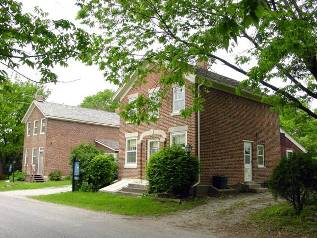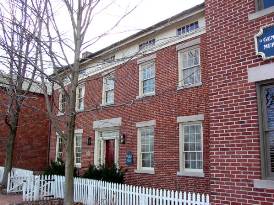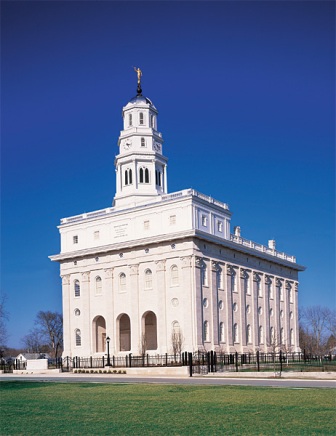Difference between revisions of "Nauvoo"
(→Restoring Nauvoo and Rebuilding the Temple) |
(→Restoring Nauvoo and Rebuilding the Temple) |
||
| (2 intermediate revisions by the same user not shown) | |||
| Line 29: | Line 29: | ||
==Later History== | ==Later History== | ||
| − | Joseph and Hyrum Smith were martyred at [[Carthage Jail]] in 1844, throwing the Saints into mourning and introducing controversy over succession to the presidency. Things had calmed down under the leadership of [[Brigham Young]] and the [[Quorum of the Twelve Apostles]], but in 1845, Nauvoo's charter was rescinded and mob violence began against the Saints. The Twelve announced at the October 1845 general conference that evacuation of the Saints would begin the following spring. Throughout the winter, the Saints hastened to finish the temple, so they could receive the [[Ordinances|ordinances]] to be offered there. Before the end of winter, 6,000 Latter-day Saints had received their temple endowments. Endowed with power from on high, they felt ready to leave. At the same time, the Latter-day Saints prepared physically for the exodus to the west. They sold property and obtained wagons and other necessities for the journey. | + | Joseph and Hyrum Smith were martyred at [[Carthage Jail]] in 1844, throwing the Saints into mourning and introducing controversy over [[Succession Crisis|succession]] to the presidency. Things had calmed down under the leadership of [[Brigham Young]] and the [[Quorum of the Twelve Apostles]], but in 1845, Nauvoo's charter was rescinded and mob violence began against the Saints. The Twelve announced at the October 1845 general conference that evacuation of the Saints would begin the following spring. Throughout the winter, the Saints hastened to finish the temple, so they could receive the [[Ordinances|ordinances]] to be offered there. Before the end of winter, 6,000 Latter-day Saints had received their temple endowments. Endowed with power from on high, they felt ready to leave. At the same time, the Latter-day Saints prepared physically for the exodus to the west. They sold property and obtained wagons and other necessities for the journey. |
| − | |||
==Restoring Nauvoo and Rebuilding the Temple== | ==Restoring Nauvoo and Rebuilding the Temple== | ||
| Line 40: | Line 39: | ||
Updates in the Temple District include three restored homes — the Weeks (William and Caroline), Gheen (William and Esther), and Hyde ([[Orson Hyde|Orson]] and Marinda) homes, one rebuilt home (the Edward and Ann Hunter home), a new exhibit about the art of cutting stone for the original Nauvoo Temple (Instead of rebuilding the William and Elizabeth Jones home, the Church created this exhibit, as Jones was one of the stonecutters for the Nauvoo Temple), a revitalized West Grove (where Church members sat on split-log benches to listen to sermons from Joseph Smith and others) and a wayside marker that honors a poem written by [[Eliza R. Snow]] while she lived in the Temple District in 1845 ("My Father in Heaven," now known best as the hymn "O, My Father"). The Nauvoo Visitors’ Center also features a new exhibit about the temple. The Orson and Marinda Hyde was included in Elder Cook’s dedicatory prayer, though it is not part of the Temple District.[https://newsroom.churchofjesuschrist.org/article/elder-cook-dedication-temple-district-historic-nauvoo] | Updates in the Temple District include three restored homes — the Weeks (William and Caroline), Gheen (William and Esther), and Hyde ([[Orson Hyde|Orson]] and Marinda) homes, one rebuilt home (the Edward and Ann Hunter home), a new exhibit about the art of cutting stone for the original Nauvoo Temple (Instead of rebuilding the William and Elizabeth Jones home, the Church created this exhibit, as Jones was one of the stonecutters for the Nauvoo Temple), a revitalized West Grove (where Church members sat on split-log benches to listen to sermons from Joseph Smith and others) and a wayside marker that honors a poem written by [[Eliza R. Snow]] while she lived in the Temple District in 1845 ("My Father in Heaven," now known best as the hymn "O, My Father"). The Nauvoo Visitors’ Center also features a new exhibit about the temple. The Orson and Marinda Hyde was included in Elder Cook’s dedicatory prayer, though it is not part of the Temple District.[https://newsroom.churchofjesuschrist.org/article/elder-cook-dedication-temple-district-historic-nauvoo] | ||
| − | + | In 2014, the Church created a 25-year plan to improve the historic site’s core messages, historical landscapes, authenticity and guest experience by 2039 — the bicentennial of The Church of Jesus Christ of Latter-day Saints in Nauvoo. The completion of the Temple District is the first phase of that plan.[https://newsroom.churchofjesuschrist.org/article/elder-cook-dedication-temple-district-historic-nauvoo] | |
<videoflash>DjphxjHm4BU&feature=emb_imp_woyt&rel=0</videoflash> | <videoflash>DjphxjHm4BU&feature=emb_imp_woyt&rel=0</videoflash> | ||
| Line 55: | Line 54: | ||
*[https://www.nauvoohistoricsites.org/map/ Map of Nauvoo] | *[https://www.nauvoohistoricsites.org/map/ Map of Nauvoo] | ||
*[https://newsroom.churchofjesuschrist.org/article/elder-cook-dedication-temple-district-historic-nauvoo "Elder Cook Dedicates the Restored Temple District in Historic Nauvoo"] | *[https://newsroom.churchofjesuschrist.org/article/elder-cook-dedication-temple-district-historic-nauvoo "Elder Cook Dedicates the Restored Temple District in Historic Nauvoo"] | ||
| − | [[Category:Places of Church Interest]][[Category:Historical Sites]][[Category:Church History: Miscellaneous Topics]] | + | [[Category:Places of Church Interest]][[Category:Historical Sites]][[Category:Church History: Miscellaneous Topics]][[Category:Joseph Smith]] |
[[es:Nauvoo]] | [[es:Nauvoo]] | ||
Revision as of 12:12, 29 January 2022

The focus of this article is on the city of Nauvoo. For a history of the Nauvoo period of The Church of Jesus Christ of Latter-day Saints, go to the article called Nauvoo and the Martyrdom.
Contents
Early History
Nauvoo was the central location of The Church of Jesus Christ of Latter-day Saints and home to most of its members from 1839 to 1846. In 1839 the Saints were forced to flee from Missouri, while Joseph Smith and other leaders were incarcerated for the winter in Liberty Jail. After so much persecution, the Saints having been driven from their homes time and time again, many doubted that they should regather in any central location. However, the citizens of Quincy, Illinois, had cared for the fleeing Saints with Christian generosity, and land was available to be purchased on the Mississippi River, in Commerce, Illinois. Commerce was essentially a failed community. Its inhabitants had hoped to engage in trade due to the city's orientation on the river, but the area turned out to be a mosquito-infested, malarial swamp. The Saints bought property on both sides of the river, in Illinois and Iowa, and Joseph named the new Illinois city "Nauvoo," meaning beautiful in Sephardic Hebrew.
Latter-day Saints flooded into the area, not only for refuge from the pogroms in Missouri, but as a new home for new converts. Thousands sailed the Atlantic from Europe to join the Saints in Nauvoo. Eventually, Nauvoo would rival 1840s Chicago in size. Land was purchased from settlers and speculators, who sold the land on contract. In December of 1840, Nauvoo became a legal entity under the Nauvoo Charter. Although the charter was similar to other Illinois contracts, especially the Springfield charter, the charter issued by the state legislature offered the Saints more legal protection than they had ever known. Two important aspects of the charter were the ability to maintain a militia—the Saints had learned from hard experience that they might have to defend themselves—and the demand for habeas corpus, the necessity to provide evidence before nabbing and arresting Church leaders. This writ protected Joseph Smith and others from being extradited to Missouri on fake charges. [1]
The building boom in Nauvoo was especially marked in 1841–1843. It became difficult for newcomers to find temporary lodging. Joseph Smith's family took in guests on a continuing basis.
The City

After suffering devastating sickness caused by the swamp and mosquitoes, early settlers managed to reclaim the land and build a thriving city. The city was a community of gardens, and visitors commented on its orderliness and fruitful beauty. Gardens on the city lots produced vegetables, fruit, berries, and herbs. In outlying areas, farmers established cooperative farms, which produced wheat, corn, and potatoes. A brickyard was established, and soon brick homes dotted the landscape. Merchants and tradesmen found good business in the city. Civic groups built a cultural hall and a music hall, and the Saints constructed a grand hotel called the Nauvoo House. The Seventy built a hall and sponsored a library. Patriotic celebrations were held on Independence Day, with bands, parades, speeches, and other festivities. There were dances and choir performances on this and other occasions. Nauvoo also was home to performing troupes, poets, and composers. Other attractions included river boat excursions, circuses, and art exhibits. Classes were offered by part-time teachers and tutors. Nauvoo provided an active social and cultural life for its citizins.[3]
Religious life, of course, was vibrant, with the prophet Joseph revealing the doctrines of Baptism for the Dead and eternal marriage, and delivering sermons to hundreds outside in the open air.
The Nauvoo Temple
Joseph received a revelation to build the Nauvoo Temple. Construction was begun in the fall of 1840. The final cost reached $1,000,000 and taxed the resources of the Saints, many of whom were destitute at the time. This would be the second temple built by the church, with the Kirtland Temple being the first. "It was said that when seen from the opposite side of the river, the Nauvoo Temple presented one of the “most beautiful, chaste, and noble specimens of architecture to be found in the world.”[4] Its tower and spire were visible from twenty miles away.
- No effort was spared. No sacrifice was too great. Through the next five years men chiseled stone and laid footings and foundation, walls and ornamentation. Hundreds went to the north, there to live for a time to cut lumber, vast quantities of it, and then bind it together to form rafts which were floated down the river to Nauvoo. Beautiful moldings were cut from that lumber. Pennies were gathered to buy nails. Unimaginable sacrifice was made to procure glass. They were building a temple to God, and it had to be the very best of which they were capable.[5]
Joseph never lived to see the completion of the temple, due to his martyrdom in Carthage, Illinois. However, the Saints were able to complete the temple in May 1846, and some of them were able to receive the Temple endowment ceremony.
- Ordinance work was begun before the temple was entirely completed. It went on feverishly until, in the cold of the winter of 1846, the people began to close the doors of their homes and wagons moved slowly down Parley Street to the water’s edge, then across the river and up the banks on the Iowa side.
- Movement continued. The river froze over, it was so bitter cold. But it made it possible for [the Saints] to move on the ice.
- Back to the east they looked for the last time to the city of their dreams and the temple of their God. Then they looked to the west to a destiny they did not know.
- The temple was subsequently dedicated, and those who dedicated it said “amen” and moved on. The building was later burned by an arsonist who almost lost his life in the evil process. A tornado finally toppled most of what was left. The house of the Lord, the great objective of their labors, was gone.[6]
The building materials were then used in many other buildings in the surrounding area. The Smithsonian has one of the original sunstones from the temple. Another is in the Museum of Church History and Art.
Later History
Joseph and Hyrum Smith were martyred at Carthage Jail in 1844, throwing the Saints into mourning and introducing controversy over succession to the presidency. Things had calmed down under the leadership of Brigham Young and the Quorum of the Twelve Apostles, but in 1845, Nauvoo's charter was rescinded and mob violence began against the Saints. The Twelve announced at the October 1845 general conference that evacuation of the Saints would begin the following spring. Throughout the winter, the Saints hastened to finish the temple, so they could receive the ordinances to be offered there. Before the end of winter, 6,000 Latter-day Saints had received their temple endowments. Endowed with power from on high, they felt ready to leave. At the same time, the Latter-day Saints prepared physically for the exodus to the west. They sold property and obtained wagons and other necessities for the journey.
Restoring Nauvoo and Rebuilding the Temple
Much restoration has been ongoing in Historic Nauvoo[6] in recent years, with many prominent buildings now restored and furnished with period pieces. President Gordon B. Hinckley announced in April 1999 that the Nauvoo Temple would be rebuilt. It was completed in June 2002.- How grateful I am, how profoundly grateful for what has happened. Today, facing west, on the high bluff overlooking the city of Nauvoo, thence across the Mississippi, and over the plains of Iowa, there stands Joseph’s temple, a magnificent house of God. Here in the Salt Lake Valley, facing east to that beautiful temple in Nauvoo, stands Brigham’s temple, the Salt Lake Temple. They look toward one another as bookends between which there are volumes that speak of the suffering, the sorrow, the sacrifice, even the deaths of thousands who made the long journey from the Mississippi River to the valley of the Great Salt Lake.[7]
Elder Quentin L. Cook dedicated the restored temple district in Nauvoo. The Temple District of Nauvoo — the area near and inclusive of the Nauvoo Temple, which was first completed in 1846 and rebuilt in 2002 — was dedicated on Saturday, May 29, 2021. The renovation of the Historic Nauvoo Temple District is a follow-up to the reconstruction of the Nauvoo Temple in 2002. “With that magnificent building on the bluff overlooking the Mississippi River, it became really clear [after 2002] that there was an important message missing in Historic Nauvoo — and that was, ‘Why is this building here, and why did these people construct it [in the 1840s]?’” said Church Historic Sites Director Jenny Lund.[7]
Updates in the Temple District include three restored homes — the Weeks (William and Caroline), Gheen (William and Esther), and Hyde (Orson and Marinda) homes, one rebuilt home (the Edward and Ann Hunter home), a new exhibit about the art of cutting stone for the original Nauvoo Temple (Instead of rebuilding the William and Elizabeth Jones home, the Church created this exhibit, as Jones was one of the stonecutters for the Nauvoo Temple), a revitalized West Grove (where Church members sat on split-log benches to listen to sermons from Joseph Smith and others) and a wayside marker that honors a poem written by Eliza R. Snow while she lived in the Temple District in 1845 ("My Father in Heaven," now known best as the hymn "O, My Father"). The Nauvoo Visitors’ Center also features a new exhibit about the temple. The Orson and Marinda Hyde was included in Elder Cook’s dedicatory prayer, though it is not part of the Temple District.[8]
In 2014, the Church created a 25-year plan to improve the historic site’s core messages, historical landscapes, authenticity and guest experience by 2039 — the bicentennial of The Church of Jesus Christ of Latter-day Saints in Nauvoo. The completion of the Temple District is the first phase of that plan.[9]
References
- ↑ "Nauvoo," Encyclopedia of Mormonism, p. 987. [1]
- ↑ Wikipedia, "Nauvoo" [2]
- ↑ "Nauvoo," Encyclopedia of Mormonism, p. 987. [3]
- ↑ M. Russell Ballard, “The Legacy of Hyrum,” Ensign, Sep 1994, 55–58. [4]
- ↑ Gordon B. Hinckley, “‘O That I Were an Angel, and Could Have the Wish of Mine Heart’,” Ensign, Nov 2002, 4. [5]
- ↑ Ibid.
- ↑ Ibid.
